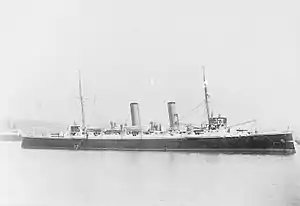HMS Flora (1893)
HMS Flora was an Astraea-class cruiser of the Royal Navy launched on 21 November 1893.[2] She was constructed under the Naval Defence Act 1889 along with several other Astraea-class cruisers.[3] Flora was decommissioned in 1922.
 HMS Flora | |
| History | |
|---|---|
| Name | HMS Flora |
| Builder | Pembroke Dock |
| Launched | 21 November 1893 |
| Commissioned | 24 July 1895[1] |
| Decommissioned | March 1922 |
| Renamed | TS Indus II in April 1915 |
| Fate | Sold 12 December 1922 for breaking up in Dover |
| General characteristics | |
| Class and type | Astraea-class cruiser |
| Displacement | 4,360 long tons (4,430 t) fully loaded |
| Length | 320 ft (98 m) |
| Beam | 49 ft 6 in (15.09 m) |
| Draught | 19 ft (5.8 m) |
| Propulsion |
|
| Speed |
|
| Range | 7,000 nmi (13,000 km) |
| Complement | 44 |
| Armament | |
| Armour |
|
Operational history
HMS Flora served a commission, under the command of Commodore Robert Leonard Groome and later of Captain Frederick Sidney Pelham, as senior officer′s ship on the South East Coast of America Station until June 1901, when she returned to Devonport to pay off.[4]
She was commissioned at Devonport on 11 November 1902[5] to relieve HMS Phaeton for service on the Pacific Station.[6] Leaving Plymouth in late November,[7] she stopped in Funchal, Saint Vincent, Pernambuco and Montevideo before she arrived at the station early the following year.[8]
HMS Flora was the subject of a famous salvage operation after running aground in 1903.[9]
_circa_1915_DRN027.jpg.webp)
In 1914, just prior to the First World War, Flora was placed on the sale list and remained on harbour service for the majority of the conflict. In April 1915 Flora was renamed TS Indus II. She was sold on 12 December 1922 and was broken up at Dover.

References
- The Times (London), Thursday, 25 July 1895, p.10
- Colledge, J. J.; Warlow, Ben (2006) [1969]. Ships of the Royal Navy: The Complete Record of all Fighting Ships of the Royal Navy (Rev. ed.). London: Chatham Publishing. ISBN 978-1-86176-281-8.
- Historyofwar.org
- "Naval & Military intelligence". The Times. No. 36476. London. 8 June 1901. p. 9.
- "Naval & Military intelligence". The Times. No. 36902. London. 18 October 1902. p. 9.
- "Naval & Military intelligence". The Times. No. 36922. London. 11 November 1902. p. 5.
- "Naval & Military intelligence". The Times. No. 36936. London. 27 November 1902. p. 7.
- "Naval & Military intelligence". The Times. No. 36948. London. 11 December 1902. p. 10.
- Wreckers at Work on H.M.S. Flora, New York Times, 5 December 1903
- http://www.olddevonport.uk/Royal%20Navy%20in%20Old%20Devonport-Training%20Ships-HMS%20Indus.htm
Publications
- Colledge, J. J.; Warlow, Ben (2006) [1969]. Ships of the Royal Navy: The Complete Record of all Fighting Ships of the Royal Navy (Rev. ed.). London: Chatham Publishing. ISBN 978-1-86176-281-8.